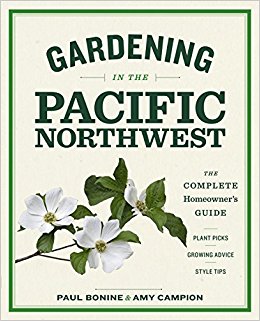![[Our Native Bees] cover](https://depts.washington.edu/hortlib/graphix/ournativebees.jpg)
Paige Embry is an engaging and humorous writer exploring the topic of bees. And not just any bees. She is passionate about “Our Native Bees”, which is also the title of her new book. She gives honey bees their due, but laments they “get all the press – the books, the movie deals – and they aren’t even from around here.”
While I haven’t seen many movies on honey bees, the author makes her point. We have native bees that are far better pollinators, do equal work with fewer numbers, fly in nastier weather, and often use better technique. An example of the latter is buzz pollination, or shaking the pollen from the flower. Honey bees haven’t learned this trick, but bumble bees and others have and their work facilitates some of our favorite foods, including tomatoes.
This is not a field guide. While the author lives in Seattle, her scope for natives includes most of North America. There are some excellent, close-up photographs, but their purpose is to supplement the text, not help with ID. Instead, this is an investigative study of many apian topics and to recognize that bees are diverse and have the power to fascinate people, even when we mislabel or misunderstand them.
One of the author’s major themes is agriculture. For example, she studies the production of lowbush blueberries in Maine and neighboring New Brunswick, an interwoven history of wild plants, wild bees, managed plants, managed bees, and the impact of various attempts at pest management. Recounting this could be deadly dull, but in Emery’s hands, it is most engaging.
Throughout all the stories, there are questions asking what is possible. Can native bees provide better solutions for our pollinating needs? Can we provide better solutions for the needs of native bees? The author provides some answers to these questions, but I think her underlying goal is that we join her on a journey to a better understanding and appreciation of the diversity of bees, especially native bees.
Excerpted from the Spring 2018 Arboretum Bulletin.
 It is no secret that Barbara Blossom Ashmun is an avid gardener. Besides having a floriferous name, there are the intimate titles of her memoirs: “Married to My Garden” (2003) and “Love Letters to My Garden” (2017). This Portland garden designer and writer did not grow up as a gardener, but instead found her calling well into adulthood. A divorce and the desire to leave the world of a social worker helped this process.
It is no secret that Barbara Blossom Ashmun is an avid gardener. Besides having a floriferous name, there are the intimate titles of her memoirs: “Married to My Garden” (2003) and “Love Letters to My Garden” (2017). This Portland garden designer and writer did not grow up as a gardener, but instead found her calling well into adulthood. A divorce and the desire to leave the world of a social worker helped this process. “The Northwest Garden Manifesto” by John Albers is a new book for our region. While the title may conjure up images of gardeners marching rake-to-rake for their causes, this instead is a very solid and comprehensive gardening book that keeps closely in mind the bigger ecosystem surrounding any private garden. Divided into three broad sections, the book asks you to assess what you have, then make changes that are sustainable (for your garden) and healthful (for you), and finally – for all your actions – think outside the property line.
“The Northwest Garden Manifesto” by John Albers is a new book for our region. While the title may conjure up images of gardeners marching rake-to-rake for their causes, this instead is a very solid and comprehensive gardening book that keeps closely in mind the bigger ecosystem surrounding any private garden. Divided into three broad sections, the book asks you to assess what you have, then make changes that are sustainable (for your garden) and healthful (for you), and finally – for all your actions – think outside the property line. I always look forward to new books intended for Pacific Northwest gardeners. Paul Bonine and Amy Campion’s “Gardening in the Pacific Northwest” has been long anticipated, and it doesn’t disappoint. As explained in the introduction, this book is mostly from Bonine’s perspective, as he grew up here and has gardened in this region for many years. Campion did most of the excellent photography.
I always look forward to new books intended for Pacific Northwest gardeners. Paul Bonine and Amy Campion’s “Gardening in the Pacific Northwest” has been long anticipated, and it doesn’t disappoint. As explained in the introduction, this book is mostly from Bonine’s perspective, as he grew up here and has gardened in this region for many years. Campion did most of the excellent photography.![[RHS Genealogy for Gardeners]]cover](https://depts.washington.edu/hortlib/graphix/RHSGenealogyforgardeners (2).jpg)
![[Saving Tarboo Creek]]cover](https://depts.washington.edu/hortlib/graphix/savingtarboocreek.jpg)
![[Companions in Wonder]]cover](https://depts.washington.edu/hortlib/graphix/Companionsinwonder.jpg)
 Thomas Liptan introduces his new book,
Thomas Liptan introduces his new book, 